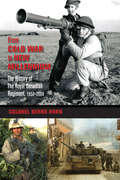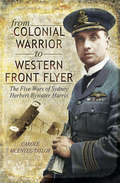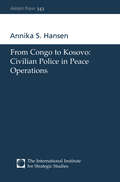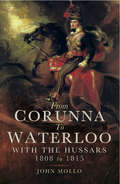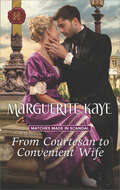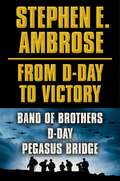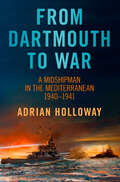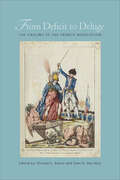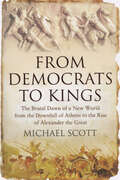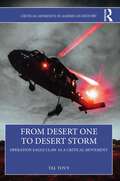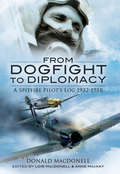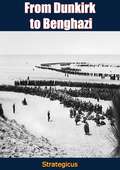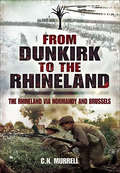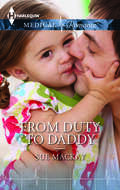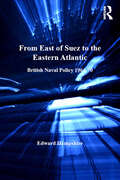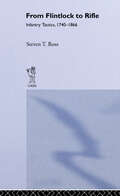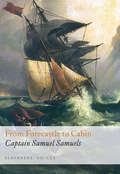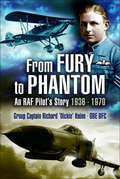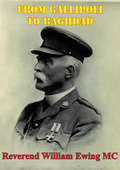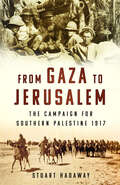- Table View
- List View
From Cold War to New Millennium: The History of The Royal Canadian Regiment, 1953–2008
by Colonel Bernd HornCanadian regimental histories are war stories that provide testimony to the feats of courage and tenacity of Canadians tested in combat or engaged in the sometimes tedious regimen of peace. These regimental histories speak to the collective military heritage and legacy of the country. They are, in fact, windows on our nation and ourselves. This volume, the companion to Establishing a Legacy, the first volume, provides a detailed account of The Royal Canadian Regiments story from 1953 to 2008.The RCRs history after the Korean War paralleled the growth and evolution of Canada through dangerous and trying times, from the brink of nuclear Armageddon to a freefall of global destabilization, economic catastrophe, resurging global terrorism, and the birth of transnational terror networks. The RCR contributed to the victory in the Cold War, participated in the bitter stabilization campaigns of the 1990s in the former Yugoslavia, and fought and bled heavily in the reconstruction and counter-insurgency battle in Afghanistan.
From Colonial Warrior to Western Front Flyer: The Five Wars of Sydney Herbert Bywater Harris
by Carole McEntee-TaylorSydney Herbert Bywater Harris was an adventurer, a man possessed of great courage and charm, who fulfilled every schoolboy fantasy and really did 'live the dream'. The second youngest of seven children, the ordinary life held little appeal for Sydney so, in 1898, at the age of 17, he left home in Ilford for the Klondike gold rush. Arriving too late to make his fortune he decided to join the US Army.Two and a half years later, after seeing action in the Boxer Rebellion and the Philippines Insurrection, Sydney returned to England where he met and married Elsa de Verde Verder, a lady from an affluent Vermont family. A year later Sydney joined the Kings Colonials Imperial Yeomanry, later renamed the King Edward's Horse. Still seeking excitement, in August 1914 he transferred to the Royal Flying Corps and in 1916 went to France with 23 Squadron to fly the FE2b. Life expectancy for pilots on the front lines was very short and he was badly wounded while gun-spotting over enemy lines. After several months recovering he was posted to Turnberry as Chief Instructor and on the 13th August 1917, he was posted to Marske (by-the-Sea), with the rank of Lieutenant Colonel, to form and command No.2 Fighting School. In 1919 he was awarded the Air Force Cross.But war was not quite finished with Sydney. In 1936, fleeing imminent bankruptcy, he became involved with the International Brigades in the Spanish Civil War. Returning back to England he joined the RAFVR (Royal Air Force Volunteer Reserve) and when the Second World War broke out he was posted to Turnhouse as Section Controller. This really didn't suit him and, determined to see more action, at the age of 58, he arranged a transfer to France as Adjutant with No 1 Squadron where his duties included liaising with the French Air Force. He later transferred to 1 ATS near Perpignan and was one of the last to leave France with the German Blitzkrieg only a few hours away. Despite his ill health he continued to serve throughout the war and in 1947 became Commander at Marchwood Park where the members of the 'Guinea Pig' club went to recover.A remarkable life led in an era of endless possibilities.Royalties from this book will go to Help 4 Homeless Veterans who support Servicemen and women into suitable accommodation, and empower them to develop a civilian career through their links with employers and other organisations.
From Congo to Kosovo: Civilian Police in Peace Operations (Adelphi series #343)
by Annika S HansenAn examination of the role of civilian police in peace operations, which has expanded greatly since the early 1990s and has culminated in international policemen assuming responsibility for law and order in Kosovo and East Timor. It looks at the way civilian police play a critical role in reforming local police forces and at times enforcing the law themselves.
From Corunna to Waterloo: With The Hussars 1808 To 1815
by John MolloBasing his story on contemporary letters, diaries and reports and a comprehensive bibliography, John Mollo takes the reader into the heart of the Hussar Brigade in peace and war, depicting its many colourful characters with a sure hand and describing every facet of day-to-day life, in barracks and on the battlefield. This is a story based on the harsh realities of war in the early years of the nineteenth century. Written with great elegance, the touch of a natural story teller and the imprint of a true lover and student of military history, this is a book to treasure.
From Courtesan to Convenient Wife (Matches Made in Scandal #2)
by Marguerite KayeAn Englishwoman is hired to masquerade as a Parisian wine merchant’s bride, but her secret past could cause trouble in this Regency romance.In this Matches Made in Scandal story, Jean-Luc Bauduin, Parisian society’s most eligible bachelor, is determined to take only a wife of his choosing. But until that day comes, he’ll ward off his admirers by hiring Lady Sophia Acton to wear his ring! The passion Jean-Luc shares with his convenient bride is enormously satisfying—until he discovers Sophia’s utterly scandalous past!Matches Made in Scandal series:From Governess to CountessFrom Courtesan to Convenient WifeHis Rags to Riches ContessaA Scandalous Winter WeddingPraise for the novels of Marguerite Kaye“Readers will be seduced by the passionate natures of the protagonists, and the fast-paced, thrilling adventure.” —RT Book Reviews on The Harlot and the Sheikh
From D-Day to Victory Boxed Set
by Stephen E. Ambrose“This e-book box set includes the following books by Stephen E. Ambrose, chronicling the pivotal moments from WWII—from D-Day to the capture of Hitler’s Eagle’s Nest. Band of Brothers: A riveting account of Easy Company, 506th Airborne Division, U.S. Army—responsible for everything from parachuting into France early D-Day morning to the capture of Hitler's Eagle's Nest at Berchtesgaden. Drawing on hours of interviews with survivors as well as the soldiers' journals and letters, here are the stories, often in the men's own words, of these American heroes. D-Day: The preeminent chronicle of the most important day in the twentieth century —drawn from more than 1,400 interviews with American, British, Canadian, French, and German veterans. Pegasus Bridge: A gripping account of the first engagement of D-Day—Pegasus Bridge. In the early morning hours of June 6, 1944, a small detachment of British airborne troops stormed the German defense forces and paved the way for the Allied invasion of Europe. Ambrose traces each step of the preparations over many months to the minute-by-minute excitement of the hand-to-hand confrontations on the bridge.”
From Dartmouth to War: A Midshipman in the Mediterranean 1940-1941
by Adrian HollowayAdrian Holloway was only seventeen when he left the Royal Naval College at Dartmouth in 1940 and joined HMS Valiant as a Midshipman, sharing a gunroom with Midshipmen Terry Lewin and HRH Prince Philip. He arrived in the Mediterranean in time to witness the darkest days of the Mediterranean Fleet – providing cover for the Fleet Air Arm’s raid on Taranto, fighting at the Battle of Matapan and taking part in the evacuation of Crete – during which time the Royal Navy’s vessels were decimated. He also witnessed the sinking of HMS Barham, and after returning from an appointment to the Australian destroyer HMAS Nizam, was back on board Valiant when Italian frogmen mined her in Alexandria Harbour in 1941.In From Dartmouth to War Adrian Holloway presents a fascinating first-hand account of the war at sea, vividly recalling what it was like to be in battle whilst still little more than a schoolboy. He describes the transition from the safety of Dartmouth to the terror and confusion of the open ocean, at a time when Britain stood alone against the Axis. Complete with personal photographs, track charts and naval signals, this book provides an invaluable insight into the wartime activities of a junior officer.
From Deficit to Deluge: The Origins of the French Revolution
by Thomas E. Kaiser Dale K. Van KleyFrom Deficit to Deluge takes stock of shifts in scholarly investigation of the origins of French Revolution. During the last decade, scholars have moved beyond "revisionist" historians of the 1970s, who highlighted the monarchy's degeneration into despotism, to explore related conflicts in the realms of finance, social relations, religion, diplomacy, the Enlightenment, and colonial policy. In this book, seven established authorities explore some of these critical intersections, and together they make clear the role that unresolved tensions in these realms played in the essentially political narrative told by post-Marxian revisionist historiography. While each chapter of From Deficit to Deluge focuses upon one site of contention--fiscal, social, religious, diplomatic, ideological, and colonial--they all help to explain how long-standing structural problems of the Old Regime caused a fairly "normal" fiscal crisis to metastasize into a revolution. As the editors show in their introduction and conclusion, the growing democratization of politics sparked by the monarchy's clumsy efforts to solve the fiscal crisis put these wide-ranging problems at the epicenter of political debate, thereby sapping the foundations of royal authority and the social hierarchy.
From Democrats to Kings: The Brutal Dawn of a New World from the Downfall of Athens to the Rise of Alexander the Great
by Michael ScottA popular history of how the ancient world turned from a democracy to a monarchy and &“shine[s] a light on the culture that bloomed as Athens faded.&”(The Daily Mail) Athens, 404 BC. The Democratic city-state has been ravaged by a long and bloody war with neighboring Sparta. The search for scapegoats begins and Athens, liberty's beacon in the ancient world, turns its sword on its own way of life. Civil war and much bloodshed ensue. Defining moments of Greek history, culture, politics, religion and identity are debated ferociously in Athenian board rooms, back streets and battlefields. By 323 BC, Athens and the rest of Greece, not to mention a large part of the known world, has come under the control of an absolute monarch and a model for despots for millennia to come: Alexander the Great. In this superb popular history, Michael Scott explores the dramatic and little-known story of how the ancient world went from democracy to monarchy in less than 100 years. A superb example of popular history writing, From Democrats to Kings gives us a fresh take on the challenges we face today as democracies—old and new—fight for survival, in which war-time and peace-time have become indistinguishable and in which the severity of the economic crisis is only matched by a crisis in our own sense of self. &“Accessible and punchy . . . a wide readership cannot fail to be entertained as well as instructed about a world that is both familiar and alien, modern as well as ancient.&” —Paul Cartledge, author of Thermopylae &“Gloriously entertaining and provocative.&” —Tom Holland, author of Rubicon, Persian Fire
From Desert One to Desert Storm: Operation Eagle Claw as a Critical Movement (Critical Moments in American History)
by Tal TovyThis book recounts the history of the US Special Operations Forces (SOF) after the failure of Operation Eagle Claw in 1980, examining the events that led to and followed a series of organizational and operational reforms in the American military system.Operation Eagle Claw’s damage to America’s image was a critical moment in American miliary history that extended beyond the exclusive purview of the military. The establishment of the Special Operations Command in 1987 would mark the only time to date that Congress has ever directed the executive branch to establish a military command. This book surveys the decades leading up to and proceeding Operation Eagle Claw, beginning with the SOF in the years after Vietnam and ending with the SOF’s performance in Operations Just Cause and Desert Storm.With thoughtful analysis and supplementary primary source documents, From Desert One to Desert Storm: Operation Eagle Claw as a Critical Movement is a useful resource for courses on American military history, the Cold War, and the United States and the Middle East.
From Dieppe to D-Day: The Memoirs of Vice Admiral ‘Jock’ Hughes-Hallett
by John 'Jock' Hughes-HallettWhen studying the planning behind the Combined Operations cross-Channel raids that harassed the Germans along the coast of Occupied France during the Second World War, one name appears repeatedly – that of Captain John ‘Jock’ Hughes-Hallett. Hughes-Hallett was Deputy Director of the Local defense Division at the Admiralty in 1940 and 1941, before becoming Naval Adviser at Combined Operations Headquarters. Along with the head of Combined Operations, Lord Louis Mountbatten, Hughes-Hallett orchestrated the Commando raids from Norway to Normandy – attacks which tied down German troops far in excess of the numbers employed on the raids. Hughes-Hallett became Commodore commanding the Channel Assault Force (known as ‘J’ Force) and Naval Chief of Staff (X) from 1942 to 1943. He is perhaps best known for being the Naval Commander of the Dieppe Raid of August 1942, and attack which, despite its disastrous outcome, led to one of the most important decisions regarding the D-Day landings of June 1944. At a meeting following the Dieppe raid, Hughes-Hallett declared that if a port could not be captured, then one should be taken across the Channel. Although this was met with derision at the time, the concept of Mulberry Harbours began to take shape when Hughes-Hallett moved to be Naval Chief of Staff to the Operation Overlord planners. It was in the planning for D-Day that the then Commodore Hughes-Hallett’s experience came to the fore. The ultimate success of that enormously complex operation owed much to his many years in Combined Operations. Hughes-Hallett retired from the Royal Navy with the rank of Vice Admiral, taking up a new career as Member of Parliament for Croydon East and then Croydon North East. It is remarkable that the Hughes-Hallett memoirs have not been published until now for, without doubt, they constitute one of the most important wartime autobiographies to presented to the world in recent decades.
From Dogfight to Diplomacy: A Spitfire Pilot's Log, 1932–1958
by Donald MacDonellMacDonell's service career began in the 1920s. Shortly before the war he became a Squadron Leader and worked at the Air Ministry during the Phoney War. When hostilities commenced he became CO of No 64 Squadron, carrying out convoy support operations and eventually fighting in the Battle of Britain. Awarded a DFC, he was given command of a squadron at Leconfield to train urgently required pilots. Eventually he was shot down over the English Channel and rescued by a U-boat, this resulted in a lengthy period as a PoW in camps throughout enemy occupied Europe and Germany. During this period he was involved with the famous 'Wooden Horse' escape and was eventually freed by advancing Russian troops.Upon his return to the UK he was promoted Wing Commander and worked on the Cabinet Office staff before moving to Headquarters Flying Training Command. He was then appointed Chief Flying Instructor at Cranwell before successfully applying for the post of British Air Attach in Moscow.
From Down Under To Nippon: The Story Of Sixth Army In World War II
by General Walter KruegerA fascinating view of the Pacific War by the victorious commander of the US Sixth Army, who led his men through the islands and jungles against the Imperial Japanese Army to final victory in recapturing the Philippines.“ALTHOUGH NEARLY EIGHT YEARS have passed since the end of the war with Japan, the story of the conspicuous part Sixth Army played in it remains to be told. Instead of publishing my personal reminiscences of the events in which I participated, I decided to write the story of Sixth Army. I felt that I owed this to all who served under me there—in particular to the many thousands who laid down their lives.The result is an unadorned narrative of the long trek of Sixth Army “from Down Under to Nippon”; of much bitter fighting; of hardships and shortcomings, as well as outstanding performances; of luck and of victory. The story is based upon my own official reports and those from my subordinate units, and upon my own notes and recollections. It stresses the bold and brilliant strategic plans of our Commander in Chief, General Douglas MacArthur, which charted our course to victory in the Southwest Pacific and which were effectively carried out by his Army-Navy-Air Forces team, of which Sixth Army formed an essential part.”—From author’s Foreword“History has not given him due credit for his greatness. I do not believe that the annals of American history have shown his superior as an Army commander. Swift and sure in the attack, tenacious and determined in defense, modest and restrained in victory—I do not know what he would have been in defeat, because he was never defeated.”—General MacArthur
From Dunkirk to Benghazi
by Strategicus“This book is a sequel to The War for World Power (1940) and proceeds on the same method. It is an attempt to select, now, what will prove to be the significant features of the war and, dealing with them episodically, to group about them the events which are logically connected with them. It carries the story of the war from the tragedy and glory of Dunkirk across the Libyan desert to Benghazi, where the latent promise of Dunkirk justified itself.“Its theme has almost a secular importance. In the months it covers, Hitler’s threat to the present world economy was more openly disclosed. In them, too, was fought out the most novel battle in the history of the world, a long-drawn out, skilful and most pitiless attack upon this country, by means of the weapon upon which the real architect of Germany’s armed might had lavished all his great powers of organization and upon which he depended for success in the enslavement of Europe and ultimately the world. A memorable conflict, summed up memorably by the Prime Minister.“This aspect of the war is more difficult to describe than any other. It seems to carry the art of warfare back to the barren matter of machines, mass and momentum which, in the teaching of all the great masters, are subsidiary to the real dominant, morale, upon which the decision of this battle turned. When all credit is paid to the honest craftsmanship and the old-fashioned prejudice for solid work, it must be admitted that it was the human skill and the human courage of a comparatively small number of men that proved decisive. They very rarely fought, if at all, except at great odds, and they never failed to inflict more damage than they received. If only for that episode, this would, indeed, deserve to be recorded as Britain’s most perfect hour.” (Strategicus)
From Dunkirk to the Rhineland: The Rhineland via Normandy and Brussels
by C.N. MurrellCharles (Charlie to his comrades) Murrell kept detailed diaries of his service with the 1st Battalion Welsh Guards throughout the Second World War as Guardsman (later Sergeant).This book starts on 10 May 1940 with the Blitzkrieg on Arras and the retreat to Dunkirk. The Dunkirk beaches and his own undignified evacuation are described in some detail and occasional humor.The second part begins on 20 June 1944 when the 1st Battalion Welsh Guards set sail for Normandy and they take part in the Battle for Caen with engagements at Cheux, Cagny and Colombelles and thence to the Bocage country with a particularly bloody fight at Montchamp.The final element covers the race for and liberation of Brussels, a fiercely fought engagement at Hechtel Operation MARKET GARDEN, Nijmegen and the Island, winter in Belgium and Holland and the Rhineland Battle.As a member of the Intelligence Section, the Author was aware of the big picture. Very observant, he has a literary style and ability unusual in a ranker. He often writes in his trench whilst under mortar or shell fire and one experiences the fear that he (and millions of others) felt. He describes several near death experiences and the casualties and deaths of his comrades and other horrors of war, sometimes in graphic detail. There are descriptions of hair-raising motorcycle rides, the fanaticism of the SS, the sadness of lettering crosses of his dead comrades, the ecstatic receptions in liberated villages and towns, culminating in the liberation of Brussels, the uneasy relationship with American troops, the importance of alcohol in his (and others) war and the joy of returning to England.The many sketches are an important accessory to the journals.
From Duty to Daddy
by Sue MacKaySwapping the firing line...Army medic Marshall Hunter has never been able to get beautiful Charlie Lang out of his head, but despite their unforgettable fling his commitment to the forces leaves no time for relationships. Two years on he's unable to pass up one last opportunity to see Charlie again! Except the little girl playing in her garden proves that she's been able to move on even if he hasn't.......for fatherhood!Only, Charlie has a life-changing surprise in store for Marshall....
From East of Suez to the Eastern Atlantic: British Naval Policy 1964-70 (Corbett Centre for Maritime Policy Studies Series)
by Edward HampshireExploring British naval policy during the first two governments of Harold Wilson (1964-70), this book analyses how the Navy Department of the Ministry of Defence and the Navy's professional leadership dealt with six years of defence reviews, retrenchment and strategic re-orientation. This period witnessed a dramatic blow to the service's self image and self confidence as a result of the cancellation of the large CVA-01 aircraft carrier, and a gradual process of realignment, reorientation and adaptation to the changed political environment, resulting in a recovery of self-confidence, a new strategy and the approval in principle of a class of small aircraft carriers. Taking advantage of the recently released official records, the study highlights for the first time just how in practice Mountbatten managed to dominate the Chiefs of Staff machinery, and how his power was undermined and diminished. It also demonstrates that, contrary to widespread historical opinion, Denis Healey was not necessarily set against carrier air power from his arrival in office and was willing to consider the procurement of a medium carrier for the navy. Furthermore, the work highlights the importance of the Mediterranean in the rehabilitation and renewal of self-confidence by the navy in the late 1960s. Although focusing primarily on policy and strategic matters, the book incorporates wider historical consideration, reviewing other factors that influenced policy-making such as foreign policy, financial resources, materiel, manpower and recruitment, in addition to the administrative machinery and the cultural environment of the time. In so doing, Dr Hampshire offers a vivid insight into the interactions of government and military at a critical juncture in the changing nature of Britain's global role.
From Eton To Ypres: The Letters And Diaries Of Lt Col Wilfrid Abel Smith, Grenadier Guards, 1914-15
by Charles SmithRegarded as one of the most outstanding commanding officers on the Western Front, Wilfrid Abel Smith commanded an elite unit of 1,000 of the finest soldiers in the British Army. Educated at Eton and Sandhurst, Smith was a career soldier who led his battalion of Grenadiers with distinction through the First Battle of Ypres and the winter trench warfare of 1914–15. He died of wounds received at the Battle of Festubert in May 1915.The letters and diaries provide a vivid, first-hand account of the fighting and suffering on the front line, written by a compassionate commander and affectionate family man. Most of his brother officers were Old Etonians, including his brigade commander, Lord Cavan, and his second-in-command, George ‘Ma’ Jeffreys. Smith’s account offers a poignant insight into the way in which the privileged world of a Guards officer responded, with the highest sense of duty and courage, to the unprecedented demands of industrial warfare.From Eton to Ypres is edited by his great-grandson, Charles Abel Smith.
From F-4 Phantom to A-10 Warthog: Memoirs of a Cold War Fighter Pilot
by Colonel Steve Ladd Steven K. LaddThis behind-the-scenes account of a USAF career is “an absorbing read, written with the classic humor fighter pilots seem to have” (Flight Line Book Review). From Baron von Richthofen to Robin Olds, the mystique of the fighter pilot endures. The skill, cunning, and bravery that characterizes this distinctive band of brothers is well known, but there are other dimensions to those who take to the skies to do battle that have not been given the emphasis they deserve—until now.You don’t have to be an aviation aficionado to enjoy Colonel Steve Ladd’s fascinating personal tale, woven around his twenty-eight-year career as a fighter pilot. This extremely engaging account follows a young man from basic pilot training to senior command through narratives that define a unique ethos. From the United States to Southeast Asia, Europe to the Middle East, the amusing and tongue-in-cheek to the deadly serious and poignant, this is the lifelong journey of a fighter pilot.The anecdotes are absorbing, providing an insight into life as an Air Force pilot, but, in this book, as Colonel Ladd stresses, the focus is not on fireworks or stirring tales of derring-do. Instead, this is an articulate and absorbing account of what life is really like among a rare breed of arrogant, cocky, boisterous, and fun-loving young men who readily transform into steely professionals at the controls of a fighter aircraft.“This book will appeal to a variety of readers with its Vietnam War combat stories and accounts of flying the Warthog in Cold War Europe. Fun, flying, international experiences—you won’t want to put it down.” —Aviation News
From Flintlock to Rifle: Infantry Tactics, 1740-1866
by Steven T. RossThis is a comprehensive study of the major changes in infantry tacticts from the time of Frederick the Great to the beginning of what many see as the era of modern war, in the 1860s. Ross lays social and political change side by side with technical change. He argues that the French revolution, due to the fervour and loyalty it inspired in its participants, led to huge citizen armies of devolved command which were able to make use of new tactics that swept the poorly paid and poorly treated professional armies of their enemies from the field. Shortly after the Napoleonic wars other European countries experienced similar social change and by the middle of the Nineteenth Century these massive conscript armies were equipped with breech-loading rifles and more powerful artillery. The battlefield of the late 1860's had become a place where close infantry formations could not survive for long in the linear formations of the past.
From Forecastle to Cabin: Seafarers' Voices
by Samuel SamuelsThis is the autobiography of an American who ran away to sea at the age of 11 and charts his rise from the lowliest seaman (berthed under the forecastle) to the command of his own ship and the occupation of the luxurious after cabin. In the course of an action-packed career spanning half a century, he experienced almost all of the vicissitudes of life in the nineteenth-century merchant service: storm and shipwreck, famine and disease, press-gangs and desertion, piracy, violence and mutiny this last, at different times, as both mutineer and victim. Like many a sailor he was often in more danger ashore than afloat, but many of his adventures make excellent stories not least his romantic, but foolhardy rescue of a Christian woman from the harem in Constantinople. In this case the story did not quite follow the script, as she married his accomplice in the rescue. Samuels is best known for his later career, as captain of the packet ship Dreadnought, a ship built especially for him and under his direction. Known as The Wild Boat of the Atlantic in the 1850s this ship was reckoned the fastest vessel on the New YorkLiverpool service, and regularly beat even the steamers on this route. This success was largely down to Samuels hard-driving style as master, and much of the latter part of the book is taken up with the resulting crew troubles, culminating in a full-blown mutiny that he put down with characteristic forcefulness.
From Fury to Phantom: An RAF Pilot's Story, 1936–1970
by Richard Haine"Richard 'Dickie' Haine first went solo in a de Havilland Gipsy Moth during August 1935, after only one week of tuition. He joined the RAF shortly afterwards as a Direct Entry Sergeant Pilot and left the service in 1970 as a Group Captain, OBE, DFC. During his long career he flew an extraordinary variety of aircraft types, starting with small biplanes that were designed upon the philosophy gained during World War I and finishing with Britain's V Bomber force and American-designed fighters at the very edge of space.His first posting was with No 25 Squadron flying Hawker Demons and Gloster Gladiators during 1936 until the unit was re-equipped with Bristol Blenheims and undertook a night-fighter role. These were difficult days during which the primitive radar system made it all but impossible to locate incoming enemy aircraft, but the squadron were also sent on several offensive missions over the recently invaded European countries. Haine was lucky to escape when his aircraft was brought down and crash-landed on a small Dutch island after an abortive raid on German occupied Walhaven airfield. After a hazardous journey on foot through the increasingly threatened lowlands he escaped on a RN Frigate. During the Battle of Britain he continued in the night-fighting role flying from Manston in Kent.Now a Commissioned officer, he was given command of No 96 Squadron, flying Boulton Paul Defiants in the night defense of the industrial heartland of England. The, after a spell as a Staff Officer at Bentley Priory, he took command of No 448 (New Zealand Squadron) who were equipped with the superlative de Havilland Mosquito. During this period the squadron had an enviable score sheet in downing enemy aircraft during many night operations. In 1945 the author was dispatched by ship to take charge of a newly formed wing to aid those forces still at war with Japan. However, whilst still at sea, the war ended and Haine found himself in Hong Kong with the task of getting Kai Tak airport operational immediately after its liberation.His post-war flying was heavily involved in the development of jet-powered fighters and sophisticated new weaponry. He spent a long period as Wing Commander in Habbinya and Akrotiri and ended his career training the navigators of the V-Bomber nuclear Force."
From Gallipoli To Baghdad [Illustrated Edition]
by Reverend William Ewing MCIncludes Gallipoli Campaign Map and Illustrations Pack -71 photos and 31 maps of the campaign spanning the entire period of hostilities.The epic story of a Chaplain attached to the 4th Battalion the Royal Scots during the First World War; ministering to his flock amid the shot and shell of the bloody failures at Gallipoli and onward to the victorious march to Baghdad."British (Scottish) author and clergyman. He was born at Corsock, near Kircudbright in the South-West of Scotland, the second son of John Ewing and Marion McCulloch, and was educated at the Universities of Glasgow and Leipzig. Following his ordination, he served as a minister in Palestine, Birmingham, and his native Scotland, He was married twice, both times to women from Hartlepool in County Durham; firstly, in 1888, to Margaret Jane Park, and, secondly, in 1896, to Elizabeth Mary Black, with whom he had one son and two daughters. In 1910, he was appointed Territorial Chaplain to the 4th. Battalion of the Royal Scots Regiment, and served as Chaplain to the Forces on Gallipoli for eight months including the evacuation, for which he was awarded the Military Cross and was mentioned in despatches. Later in the War, he was at the Suez Canal for three months and in Mesopotamia for a year, in the course of which which he was wounded at Baghdad and, again, mentioned in despatches, and a third such mention occurred with the Egyptian Expeditionary Force in the advance from Gaza to Jerusalem. After the Armistice, he became the Chaplain of St. Andrew's Church in Jerusalem. He was the author of seven books, most of which, such as "Arab and Druze at Home" (1907) and "Cedar and Palm" were concerned with the Middle East. The final line of his inscription reads, "A comforter of many.""-Memorial
From Gaza to Jerusalem: The Campaign for Southern Palestine 1917
by Stuart HadawayThe Palestine campaign of 1917 saw Britain’s armed forces rise from defeat to achieve stunning victory. After two failed attempts in the spring, at the end of the year they broke through the Ottoman line with an innovative mixture of old and new technology and tactics, and managed to advance over 50 miles, from Gaza to Jerusalem, in only two months. As well as discussions of military strategy, Stuart Hadaway’s gripping narrative of the campaign gives a broad account of the men on both sides who lived and fought in the harsh desert conditions of Palestine, facing not only brave and determined enemies, but also the environment itself: heat, disease and an ever-present thirst.Involving Ottoman, ANZAC, British and Arab forces, the campaign saw great empires manoeuvring for the coveted Holy Land. It was Britain’s victory in 1917, however, that redrew the maps of the Middle East and shaped the political climate for the century to come.
From Governess to Countess (Matches Made in Scandal #1)
by Marguerite KayeThe scandalous truth about the count’s new mistress! A Matches Made in Scandal story Count Aleksei Derevenko has hired governess Allison Galbraith for her skills as a herbalist, not a mistress! But when rumors spread, Allison is more shocked by her wanton reaction to Aleksei—inscrutable and impossibly handsome, his icy blue eyes promise white-hot nights of sin. She knows too well how fragile her reputation is, but will the price of their passion be worth paying? “Readers will be seduced by the passionate natures of the protagonists, and the fast-paced, thrilling adventure” — RT Book Reviews on The Harlot and the Sheikh “Fairytales do come true … There is plenty of action and adventure to captivate all readers” — RT Book Reviews on Sheikh’s Mail-Order Bride Matches Made in Scandal miniseries Book 1 — From Governess to Countess Book 2 — From Courtesan to Convenient Wife — coming soon
